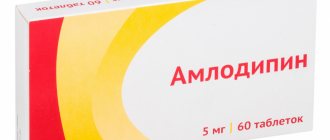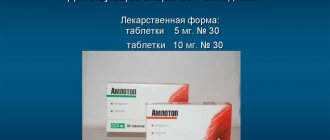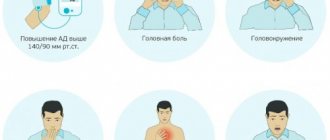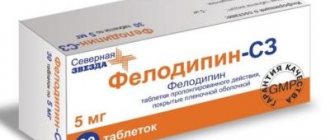Products
Composition: 1 tablet (5 mg) contains: active substance: amlodipine besylate - 5 mg, excipients: corn (potato) starch - 4.57 mg, lactose - 156 mg, microcrystalline cellulose - 9 mg, magnesium stearate - 3.5 mg
DESCRIPTION
Flat-cylindrical tablets from white to white with a creamy tint. Light marbling is allowed.
PHARMACOTHERAPEUTIC GROUP
Calcium channel blocker. ATX CODE C08CA01.
PHARMACHOLOGIC EFFECT
Antianginal, hypotensive. By binding to dihydropyridine receptors, it blocks calcium channels, reduces the transmembrane transition of calcium ions into the cell (more into vascular smooth muscle cells than cardiomyocytes).
PHARMACOKINETICS
After oral administration, it is slowly absorbed from the gastrointestinal tract. The average absolute bioavailability is 64%, Tmax is 6-9 hours. Equilibrium concentration is achieved after 7 days of therapy. Food does not affect the absorption of amlodipine. The mean volume of distribution is 21 L/kg body weight, indicating that most of the drug is in the tissues and a relatively smaller portion is in the blood. Communication with blood plasma proteins – 95%. Subject to slow but extensive metabolism (90%) in the liver, it has a “first pass” effect through the liver. Metabolites do not have significant pharmacological activity. After a single oral dose, T1/2 varies from 31 to 48 hours, and with repeated administration it is approximately 45 hours. About 60% of the dose taken orally is excreted in the urine mainly in the form of metabolites and 10% unchanged, 20 - 25% is excreted in feces , as well as with breast milk. The total Cl of amlodipine is 0.116 ml/s/kg (7 ml/min/kg, 0.42 l/h/kg). In elderly patients (over 65 years of age), the elimination of amlodipine is slower (T1/2 - 65 hours) compared to young patients, but the difference is not clinically significant. Prolongation of T1/2 in patients with liver failure up to 60 hours suggests that with long-term administration the accumulation of the drug in the body will be higher. Renal failure does not significantly affect the kinetics of amlodipine. The drug penetrates the BBB. It is not removed by hemodialysis.
INDICATIONS FOR USE
Arterial hypertension (monotherapy or in combination with other antihypertensive drugs); angina pectoris (including exertional angina), vasospastic angina (Prinzmetal's angina); silent myocardial ischemia; decompensated chronic heart failure (auxiliary therapy).
CONTRAINDICATIONS
Hypersensitivity, including to other dihydropyridine derivatives, severe arterial hypotension, collapse, cardiogenic shock, acute myocardial infarction (including 1 month after it), pregnancy and lactation, age under 18 years (efficacy and safety not installed). With caution: impaired liver function, sick sinus syndrome (severe bradycardia, tachycardia), decompensated chronic heart failure, mild or moderate arterial hypotension, aortic stenosis, mitral stenosis, hypertrophic obstructive cardiomyopathy, diabetes mellitus, lipid profile disorders, old age.
METHOD OF APPLICATION AND DOSES
Inside. For arterial hypertension and angina pectoris: initial dose - 5 mg 1 time per day; maximum dose – 10 mg 1 time per day; for arterial hypertension, the maintenance dose is 2.5 ÷ 5 mg/day. For angina pectoris and vasospastic angina - 5÷10 mg/day, once; for the prevention of angina attacks – 10 mg/day. For chronic heart failure – 2.5 mg/day. Once, if well tolerated, the dose is gradually increased to 10 mg/day. For thin patients, short patients, elderly patients, with impaired liver function, amlodipine is prescribed as an antihypertensive agent at an initial dose of 2.5 mg, and as an antianginal agent - 5 mg. Does not require dose changes when administered concomitantly with thiazide diuretics and ACE inhibitors. Does not require dose changes in patients with renal failure.
SIDE EFFECT
From the cardiovascular system: palpitations, shortness of breath, marked decrease in blood pressure, fainting, vasculitis, edema (ankles and feet), flushing of the face, rarely - rhythm disturbances (bradycardia, ventricular tachycardia, atrial flutter), pain in chest, orthostatic hypotension, very rarely - development or worsening of heart failure, extrasystole, migraine; From the nervous system: dizziness, headache, fatigue, drowsiness, mood changes, convulsions, rarely - loss of consciousness, hypoesthesia, nervousness, paresthesia, tremor, vertigo, asthenia, malaise, insomnia, depression, unusual dreams, very rarely - ataxia, apathy, agitation, amnesia; From the urinary system: rarely - pollakiuria, painful urge to urinate, nocturia, sexual dysfunction (including decreased potency), very rarely - dysuria, polyuria; From the skin: very rarely - xeroderma, alopecia, dermatitis, purpura, skin discoloration; From the gastrointestinal tract: nausea, vomiting, epigastric pain, rarely - pancreatitis, dry mouth, flatulence, gingival hyperplasia, constipation or diarrhea, jaundice, very rarely - gastritis, increased appetite. Allergic reactions: skin itching, rash (including erythematous, maculopapular urticaria), angioedema. Other: gynecomastia, hyperuricemia, weight gain/loss, thrombocytopenia, leukopenia, hyperglycemia, blurred vision, diplopia, conjunctivitis, eye pain, back pain, dyspnea, nosebleeds, increased sweating, thirst, very rarely - cold sticky sweat, cough, rhinitis, parosmia, disturbance of taste, disturbance of accommodation, xerophthalmia.
OVERDOSE
Symptoms: marked decrease in blood pressure, tachycardia, excessive peripheral vasodilation. Treatment: gastric lavage, administration of activated charcoal, maintaining the function of the cardiovascular system, monitoring indicators of heart and lung function, elevated position of the extremities, monitoring circulating blood volume and diuresis. To restore vascular tone - use vasoconstrictor drugs (in the absence of contraindications to their use), to eliminate the consequences of blockade of calcium channels - intravenous administration of calcium gluconate. Hemodialysis is not effective.
INTERACTION with other drugs
Compatible with the main groups of antihypertensive drugs (diuretics, ACE inhibitors, beta-blockers), nitrates and hypoglycemic drugs. Inhalation anesthetics (hydrocarbon derivatives), amiodarone, quinidine and other calcium antagonists can enhance the effect. NSAIDs (especially indomethacin) reduce the hypotensive effect, inhibit the synthesis of prostaglandins in the kidneys and natriuresis.
special instructions
During treatment, monitoring of body weight and sodium intake is necessary. You should maintain dental hygiene and visit the dentist frequently. When increasing the dose, careful monitoring of elderly patients is necessary. The drug does not affect plasma concentrations of K+, glucose, triglycerides, total cholesterol, LDL, uric acid, creatinine and urea nitrogen.
Precautionary measures
Caution must be exercised when prescribing to patients with hepatic and/or renal failure or chronic heart failure. At the beginning of treatment, dizziness and drowsiness are possible; in this case, special precautions must be taken when driving a car and when working with machinery.
Release form
Tablets of 5 and 10 mg. 10 tablets per blister pack. 40, 50, etc. up to 100 tablets per polymer jar. Each jar, or 1, 2 or 3 blisters, along with instructions for use, is placed in a cardboard pack.
Storage conditions
Store in a dry place, protected from light, at a temperature not exceeding 250C. Keep out of the reach of children.
Best before date
2 years. Do not use after the expiration date stated on the package.
Release form and composition
Dosage form of the drug Amlodipine-Prana - tablets: flat-cylindrical, chamfered, color from white to white with a creamy tint, slight marbling may be present; tablets at a dosage of 10 mg - with a dividing line on one side (10 pcs. in blister packs or 40, 50, 60, 70, 80, 90, 100 pcs. in polymer cans; in a cardboard pack 1 can or 1–10 blister packs).
Composition per 1 tablet:
- active substance: amlodipine – 5 or 10 mg (in the form of amlodipine besylate – 6.93 or 13.86 mg, respectively);
- auxiliary components: lactose, corn starch, magnesium stearate, microcrystalline cellulose.
Contraindications
Absolute:
- severe hypotension (systolic blood pressure <90 mmHg);
- unstable angina, except Prinzmetal's angina;
- collapse, cardiogenic shock;
- clinically significant aortic stenosis;
- lactase deficiency, lactose intolerance, glucose-galactose malabsorption;
- pregnancy period;
- breastfeeding (lactation);
- children and adolescents under 18 years of age;
- hypersensitivity to dihydropyridine derivatives, including amlodipine and other components of the drug.
Amlodipine-Prana is prescribed with caution to patients with impaired liver function, sick sinus syndrome (with severe bradycardia, tachycardia), chronic heart failure (CHF) of non-ischemic etiology of functional class III–IV according to the NYHA classification, arterial hypotension, aortic stenosis, mitral stenosis, hypertrophic obstructive cardiomyopathy (HOCM), acute myocardial infarction (and within 1 month after it), as well as in old age.
Instructions for use Amlodipine-Prana: method and dosage
Amlodipine-Pran tablets are intended for oral administration.
Recommended dosage:
- arterial hypertension and angina pectoris (treatment): initial dose – 5 mg 1 time per day; maximum dose – 10 mg 1 time per day;
- arterial hypertension (maintenance therapy): dose – 2.5–5 mg (½–1 tablet of 5 mg) 1 time per day.
Due to an increase in T1/2 of amlodipine in elderly patients and a decrease in creatinine clearance (CC), no dose changes are required, but more careful monitoring of the patients' condition is required.
Prescribing Amlodipine-Pran for renal failure, as well as simultaneously with thiazide diuretics, β-blockers and angiotensin-converting enzyme (ACE) inhibitors, does not require dose adjustment.
special instructions
During therapy, body weight and sodium intake are monitored, and an appropriate diet is prescribed if necessary.
In order to prevent bleeding, pain and hyperplasia of the gums, you should maintain oral hygiene and regularly undergo sanitation by the dentist.
Patients with low body weight, short stature and severe liver dysfunction may require a dose adjustment downward.
Stopping the drug Amlodipine-Prana does not cause withdrawal syndrome, despite this, it is advisable to complete therapy by gradually reducing the dose.
The safety and effectiveness of taking the drug during a hypertensive crisis have not been established.
Impact on the ability to drive vehicles and complex mechanisms
Due to the possible development of adverse reactions such as dizziness and drowsiness at the beginning of treatment, special precautions are required when driving vehicles and performing other types of work that require increased concentration.
Overdose
Symptoms of amlodipine overdose are excessive peripheral vasodilation with a pronounced and possibly prolonged decrease in blood pressure, collapse and shock.
To treat the condition, it is recommended to perform gastric lavage, take activated charcoal, and take measures to maintain the functioning of the cardiovascular system under the control of indicators of heart and lung function. It is necessary to provide the patient with a horizontal position, raising the lower limbs above the level of the head. It is also necessary to monitor circulating blood volume (CBV) and diuresis. In order to restore vascular tone, vasoconstrictors should be used (in the absence of contraindications), and to eliminate the consequences of calcium channel blockade, calcium gluconate should be administered intravenously. Hemodialysis is ineffective.
Side effects
Frequency of side effects according to the World Health Organization (WHO) classification (very often - > 0.1; often - > 0.01 and < 0.1; sometimes - > 0.001 and < 0.01; rarely - > 0.0001 and <0.001; extremely rare – <0.0001, including isolated reports):
- cardiovascular system: often - peripheral edema (swelling of the ankles/feet), palpitations, flushing of the face; sometimes – a significant decrease in blood pressure; extremely rarely - loss of consciousness, shortness of breath, orthostatic hypotension, vasculitis, development/worsening of heart failure, heart rhythm disturbances (including bradycardia, ventricular tachycardia and atrial fibrillation), chest pain, myocardial infarction;
- central and peripheral nervous system: often – dizziness, headache, drowsiness, increased fatigue; sometimes - general malaise, asthenia, paresthesia, hypoesthesia, peripheral neuropathy, insomnia, unusual dreams, mood lability, tremor, increased excitability, anxiety, depression; extremely rarely - migraine, hyperhidrosis, apathy;
- digestive system: often – nausea, abdominal pain; sometimes - constipation or diarrhea, vomiting, flatulence, anorexia, dyspepsia, dry mouth, thirst; rarely – increased appetite, gum hyperplasia; extremely rarely - gastritis, pancreatitis, jaundice (a consequence of cholestasis), increased activity of liver transaminases, hyperbilirubinemia, hepatitis;
- hematopoietic organs: extremely rarely - leukopenia, thrombocytopenic purpura, thrombocytopenia;
- genitourinary system: sometimes – nocturia, frequent/painful urination, impotence; extremely rarely - polyuria, dysuria;
- respiratory system: sometimes – rhinitis, shortness of breath; extremely rarely - cough;
- skin and skin: rarely – dermatitis; extremely rarely - alopecia, skin pigmentation disorder, xeroderma, cold sweat;
- hypersensitivity reactions: skin itching, skin rash (including erythematous, maculopapular and urticaria), erythema multiforme, angioedema;
- musculoskeletal system: sometimes – myalgia, arthralgia, muscle cramps, arthrosis, back pain; rarely - myasthenia gravis;
- other reactions: sometimes – diplopia, xerophthalmia, ringing in the ears, disturbance of accommodation, eye pain, conjunctivitis, nosebleeds, chills, gynecomastia; extremely rarely - parosmia, hyperglycemia.
Drug interactions
- antihypertensive drugs (thiazide diuretics, alpha-blockers, beta-blockers, ACE inhibitors): safe when used together with amlodipine for the treatment of arterial hypertension;
- antianginal agents (long- or short-acting nitrates, beta-blockers): safe when used together with amlodipine for the treatment of stable angina;
- non-steroidal anti-inflammatory drugs (NSAIDs) (especially indomethacin), antibacterial agents and oral hypoglycemic agents: simultaneous use with amlodipine is possible;
- thiazide and loop diuretics, verapamil, ACE inhibitors, beta-blockers, nitrates: may enhance the antianginal and hypotensive effects of BMCC;
- alpha1-blockers, antipsychotics: may enhance the antihypertensive effect of BMCC;
- antiarrhythmic drugs (amiodarone, quinidine): it should be taken into account that some BMCCs may increase the severity of their negative inotropic effect and cause prolongation of the QT interval;
- sildenafil: with a single dose of 100 mg in patients with essential hypertension, the pharmacokinetics of amlodipine are not affected;
- atorvastatin (at a dose of 80 mg): with repeated use with amlodipine (at a dose of 10 mg), no significant changes in the pharmacokinetic parameters of atorvastatin are observed;
- alcohol (drinks containing ethyl alcohol): with single and repeated use with amlodipine (at a dose of 10 mg), the pharmacokinetics of ethanol does not change;
- antiviral drugs (ritonavir): increase plasma concentrations of BMCC, including amlodipine;
- neuroleptics, isoflurane: potentiate the hypotensive effectiveness of dihydropyridine derivatives;
- calcium preparations: can reduce the effect of BMCC;
- lithium preparations: possible increase in manifestations of neurotoxicity (ataxia, nausea/vomiting, diarrhea, tinnitus, tremor);
- cyclosporine: amlodipine does not change its pharmacokinetics;
- Digoxin: amlodipine does not affect its serum concentration and renal clearance;
- warfarin: amlodipine does not have a significant effect on its effectiveness (prothrombin time);
- cimetidine: does not affect the pharmacokinetics of amlodipine;
- digoxin, phenytoin, warfarin, indomethacin: according to in vitro studies, amlodipine does not affect their binding to blood proteins;
- grapefruit juice: with simultaneous single oral administration of amlodipine (at a dose of 10 mg) and 240 ml of grapefruit juice, no significant changes in the pharmacokinetics of amlodipine were observed.



